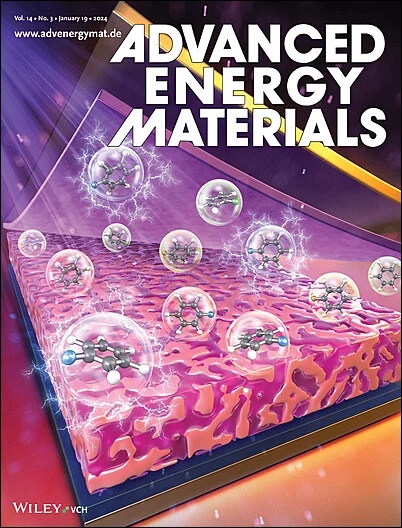2D Multivariate‐Metal‐Organic Frameworks (2D‐M2OF) for High Yield Ammonia Synthesis from Nitrate
IF 26
1区 材料科学
Q1 CHEMISTRY, PHYSICAL
引用次数: 0
Abstract
Ammonia synthesis from nitrate offers a promising approach for both nitrate removal and nitrogen recycling. In this study, a series of 2D multivariate‐metal‐organic frameworks (M2D多元-金属-有机框架(2D - M2OF)用于硝酸盐高产氨合成
硝态氮合成氨为硝态氮的去除和氮的循环利用提供了一种很有前途的方法。在本研究中,合成了一系列二维多元金属有机框架(M2OFs),并加入了Co、Ni、Mn和Ag等过渡金属来增强这些过程。这些M2OFs具有显著的制氨性能,在- 0.8 V vs RHE电流密度超过1 a cm−2的情况下,采用季元结构获得了最高的性能,氨的法拉迪效率(F.E.)约为90%,产率为68 mg h−1cm−2。我们的研究结果表明,M2OFs中不同金属中心之间的协同作用为通过表面氢共吸附还原硝酸盐提供了一种新的高效反应途径,这是单金属mof无法实现的。
本文章由计算机程序翻译,如有差异,请以英文原文为准。
求助全文
约1分钟内获得全文
求助全文
来源期刊

Advanced Energy Materials
CHEMISTRY, PHYSICAL-ENERGY & FUELS
CiteScore
41.90
自引率
4.00%
发文量
889
审稿时长
1.4 months
期刊介绍:
Established in 2011, Advanced Energy Materials is an international, interdisciplinary, English-language journal that focuses on materials used in energy harvesting, conversion, and storage. It is regarded as a top-quality journal alongside Advanced Materials, Advanced Functional Materials, and Small.
With a 2022 Impact Factor of 27.8, Advanced Energy Materials is considered a prime source for the best energy-related research. The journal covers a wide range of topics in energy-related research, including organic and inorganic photovoltaics, batteries and supercapacitors, fuel cells, hydrogen generation and storage, thermoelectrics, water splitting and photocatalysis, solar fuels and thermosolar power, magnetocalorics, and piezoelectronics.
The readership of Advanced Energy Materials includes materials scientists, chemists, physicists, and engineers in both academia and industry. The journal is indexed in various databases and collections, such as Advanced Technologies & Aerospace Database, FIZ Karlsruhe, INSPEC (IET), Science Citation Index Expanded, Technology Collection, and Web of Science, among others.
 求助内容:
求助内容: 应助结果提醒方式:
应助结果提醒方式:


